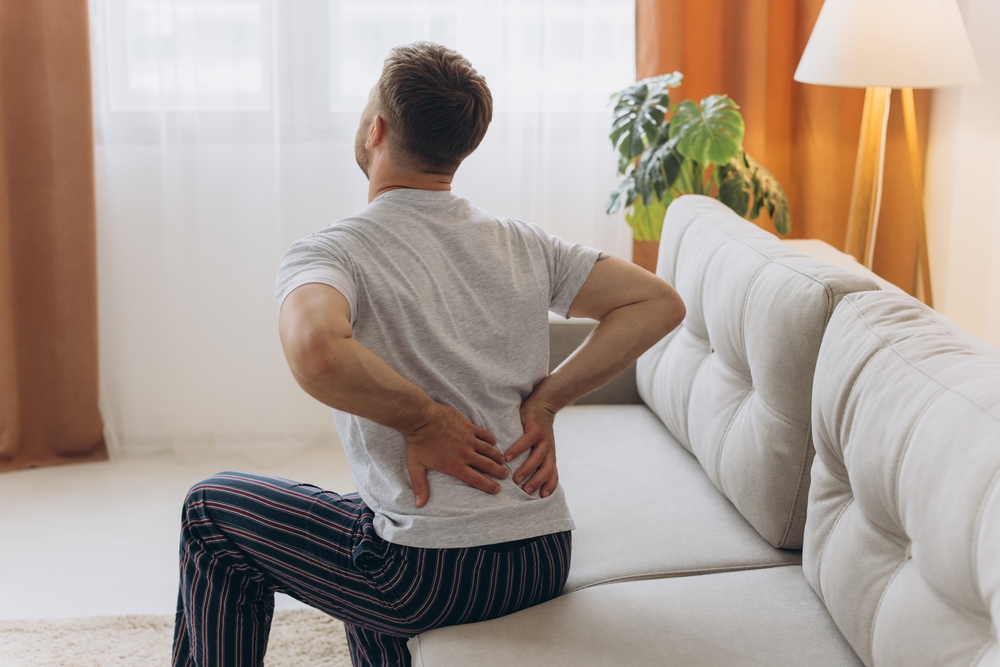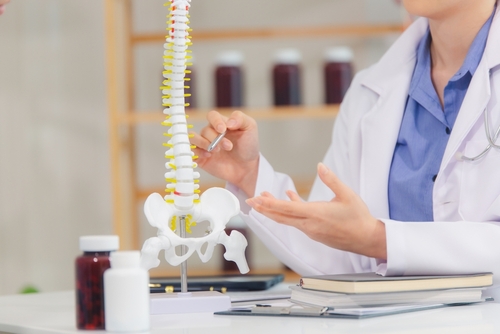Lower back pain is a common ailment that affects millions of people worldwide. It can significantly impact daily activities, work productivity, and overall quality of life. Lower back pain can be broadly categorized into two types: mechanical and inflammatory.
Understanding the differences between these two types of pain is crucial for effective treatment and management. This blog post aims to explain the distinctions between mechanical and inflammatory lower back pain, their common causes and symptoms, and the appropriate treatment options.
Understanding Mechanical Lower Back Pain
Mechanical lower back pain is the most common type of back pain, accounting for up to 90% of cases. It arises from issues related to the spine, intervertebral discs, ligaments, muscles, or other structures in the lower back. Before we dive into the specific causes and symptoms, it’s important to recognize that mechanical lower back pain often stems from the physical wear and tear of the body over time, or from specific injuries or strains.
Common Causes of Mechanical Lower Back Pain
Mechanical lower back pain can be triggered by a variety of factors. Some of the most common causes include:
- Muscle Strain or Ligament Sprain: Overuse, sudden movements, or heavy lifting can strain the muscles or sprain the ligaments in the lower back.
- Degenerative Disc Disease: As people age, the intervertebral discs can degenerate, leading to pain and reduced mobility.
- Herniated Disc: When the inner gel-like core of a disc protrudes through its outer layer, it can press on nearby nerves, causing pain.
- Spondylosis: This refers to the general wear and tear of the spine, leading to osteoarthritis and other degenerative changes.
- Spinal Stenosis: Narrowing of the spinal canal can compress the spinal cord and nerves, leading to pain and discomfort.
- Poor Posture: Chronic poor posture can strain the lower back muscles and ligaments, leading to pain.
These causes often lead to a specific set of symptoms, which help in identifying and diagnosing mechanical lower back pain.
Symptoms of Mechanical Lower Back Pain
The symptoms of mechanical lower back pain are usually straightforward and are linked to physical activity or specific movements. You may experience:
- Localized pain in the lower back, often described as aching or stiffness.
- Pain that worsens with movement, such as bending, lifting, or twisting.
- Relief from pain with rest or specific positions, such as lying down.
- Limited range of motion and difficulty in performing daily activities.
Recognizing these symptoms early can help in managing the pain effectively and preventing further injury. If you’re suffering with these symptoms, we’ve written some tips on managing lower back pain here.
Now that we’ve explored mechanical lower back pain, it’s equally important to understand another, less common but often more severe type of lower back pain: inflammatory lower back pain. Let’s delve into what sets this type of pain apart.
Understanding Inflammatory Lower Back Pain
On the other hand, inflammatory lower back pain is less common but can be more severe and chronic. It is caused by inflammation in the spinal joints and surrounding tissues, often due to autoimmune conditions. This type of pain is not just a reaction to physical strain but is linked to systemic health issues, making it more challenging to manage.
Common Causes of Inflammatory Lower Back Pain
Inflammatory lower back pain is often associated with autoimmune diseases. The most common causes include:
- Ankylosing Spondylitis (AS): A chronic inflammatory disease that primarily affects the spine and sacroiliac joints, leading to pain and stiffness.
- Psoriatic Arthritis: An inflammatory arthritis associated with psoriasis, which can affect the spine and cause lower back pain.
- Reactive Arthritis: An inflammatory condition triggered by an infection in another part of the body, affecting the spine.
- Rheumatoid Arthritis: Although it primarily affects peripheral joints, rheumatoid arthritis can also involve the spine, leading to inflammation and pain.
These conditions usually cause a more persistent form of back pain, which is accompanied by specific symptoms.
Symptoms of Inflammatory Lower Back Pain
Inflammatory lower back pain often presents with a different pattern of symptoms compared to mechanical pain. You might notice:
- Persistent pain and stiffness in the lower back, especially in the morning or after periods of inactivity.
- Pain that improves with physical activity but worsens with rest.
- Gradual onset of symptoms, often starting before the age of 40.
- Associated symptoms such as fatigue, fever, or weight loss.
- Pain that can radiate to the buttocks, thighs, or other areas.
Being aware of these symptoms is critical for early intervention, which can greatly improve the quality of life for those affected. Having outlined the causes and symptoms of both mechanical and inflammatory lower back pain, the next step is understanding the different treatment options available. Treatment can vary significantly depending on the type of pain, so let’s explore these options in detail.
Treatment Options for Mechanical and Inflammatory Lower Back Pain
Effective treatment for lower back pain depends on accurately diagnosing whether the pain is mechanical or inflammatory. Each type requires a tailored approach to manage the symptoms and underlying causes.
Treatment for Mechanical Lower Back Pain
For those suffering from mechanical lower back pain, several treatment options are available:
- Rest and Activity Modification: Avoid activities that exacerbate pain and allow the muscles and ligaments to heal.
- Physical Therapy: Strengthening and stretching exercises can improve flexibility, strength, and posture, alleviating pain.
- Medications: Over-the-counter pain relievers like NSAIDs (nonsteroidal anti-inflammatory drugs) can help reduce pain and inflammation.
- Heat and Cold Therapy: Applying heat can relax muscles, while cold packs can reduce inflammation and numb the pain.
- Chiropractic Care: Spinal adjustments by a licensed chiropractor can help alleviate mechanical pain.
- Massage Therapy: Therapeutic massage can reduce muscle tension and improve circulation, aiding in pain relief.
- Surgical Intervention: In severe cases, surgical options such as discectomy, laminectomy, or spinal fusion may be necessary.
These treatments aim to relieve pain and improve mobility, allowing individuals to return to their normal activities.
Treatment for Inflammatory Lower Back Pain
For inflammatory lower back pain, the focus is on reducing inflammation and preventing further damage. Treatment options include:
- Medications: Anti-inflammatory medications, such as NSAIDs, corticosteroids, and disease-modifying antirheumatic drugs (DMARDs), can help control inflammation and pain.
- Biologic Therapies: Biologic drugs, such as TNF inhibitors, can target specific pathways involved in inflammation, providing relief.
- Physical Therapy: Tailored exercises and stretching routines can maintain mobility and reduce stiffness.
- Lifestyle Modifications: Regular exercise, maintaining a healthy weight, and avoiding smoking can help manage symptoms.
- Alternative Therapies: Acupuncture, yoga, and mindfulness-based stress reduction techniques may provide additional relief.
- Surgical Intervention: In rare cases, surgery may be required to address severe structural damage or complications.
Early intervention and ongoing management are key to preventing the progression of inflammatory conditions. For lower back pain, chiropractors can help. We’ve written a blog about how they can treat lower back pain here.
When to Seek Medical Intervention
Lower back pain should not be ignored, especially when accompanied by specific warning signs. It’s important to seek medical attention if you experience any of the following:
- Severe or persistent pain that does not improve with self-care measures.
- Pain accompanied by neurological symptoms, such as numbness, tingling, or weakness in the legs.
- Unexplained weight loss, fever, or other systemic symptoms.
- Pain following a traumatic injury, such as a fall or accident.
- Difficulty controlling bowel or bladder function.
With the right treatment plan, individuals with inflammatory lower back pain can manage their symptoms effectively and prevent further complications.
Understanding the treatment options available for lower back pain is crucial for managing your condition effectively. However, knowing when to seek medical intervention can make a significant difference in the outcome.
Conclusion
Understanding the differences between mechanical and inflammatory lower back pain is essential for effective treatment and management. While mechanical lower back pain is often related to structural issues and can be managed with rest, physical therapy, and medications, inflammatory lower back pain requires targeted therapies to control inflammation and prevent complications.
If you experience persistent or severe lower back pain, contact us now to determine the underlying cause and receive appropriate treatment. With the right approach, you can alleviate pain, improve function, and enhance your overall quality of life.





